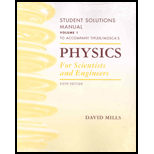
(a)
The velocity of the particle.
(a)
Explanation of Solution
Given:
The position of the particle at
The position of the particle at
The velocity of the particle is
Formula used:
Write the expression for the average velocity.
Here,
Here,
Write the expression for the average velocity of the particle.
Here,
Solve the above equation for
Calculation:
Substitute
Substitute
Conclusion:
Thus, the initial velocity is
(b)
The acceleration of the particle.
(b)
Explanation of Solution
Given:
The position of the particle at
The position of the particle at  is
is
The velocity of the particle is
Formula used:
Write the expression for the acceleration of the particle.
Here,
is the change in the velocity vector and  is the change in time.
is the change in time.
Here,
Calculation:
Substitute
Conclusion:
The acceleration of the particle is
(c)
The velocity of the particle as the function of time.
(c)
Explanation of Solution
Given:
The position of the particle at  is
is .
.
The position of the particle at  is
is
The velocity of the particle is
Formula used:
Write the expression for the velocity of the particle as the function of time.
Here,
Calculation:
Substitute
Conclusion:
Thus, the velocity of the particle as the function of timeis
(d)
The position vector of the particle as the function of time.
(d)
Explanation of Solution
Given:
The position of the particle at  is
is .
.
The position of the particle at  is
is
The velocity of the particle is
Formula used:
Write the expression for the position vector as the function of time.
Calculation:
Substitute
Conclusion:
The position vector of the particle as the function of time is:
Want to see more full solutions like this?
Chapter 3 Solutions
Physics For Scientists And Engineers Student Solutions Manual, Vol. 1
- A particle has an acceleration of a=4i + (t-2)j The velocity at t=0 is v0=-2i + 0j and is at the origin at t=0 What is the y position when the x velocity is zero? answer in m,arrow_forwardA particle moves with constant speed vo along the ellipse (x/a)^2 + (y/b)^2 = 1, where a > b. Determine the maximum acceleration of the particle.arrow_forwardA particle starts from the origin at t=0 with a velocity of (16i+12j)m/s and moves in the xy plane with a constant acceleration of a= (3.0i+6.0j)m/s^2. What is the speed of the particle at t=2.0sarrow_forward
- A particle leaves the origin with its initial velocity given by v=14.6i+12j m/s, undergoing constant acceleration a=-2.2i+0.34j m/s2. When does the particle cross the y axis?arrow_forwardA particle moves in the xy plane, starting from the origin at t = 0 with an initial velocity having an x component of 20 m/s and a y component of 215 m/s. The particle experiences an acceleration in the x direction, given by ax =4.0 m/s2.(A) Determine the total velocity vector at any later time. (B) Calculate the velocity and speed of the particle at t = 5.0 s and the angle the velocity vector makes with the x axis. (C) Determine the x and y coordinates of the particle at any time t and its position vector at this time.arrow_forwardA particle leaves the origin with initial velocity v⃗ o=12i^+12j^m/s , undergoing constant acceleration a⃗ =−1.0i^+0.28j^m/s2 . When does the particle cross the y�-axis?arrow_forward
- A rock is At t = 0, a particle leaves the origin with a velocity of 12 m/s in the positive x direction and moves in the xy plane with a constant acceleration of (–2i + 4j) m/s2. At the instant the y coordinate of the particle is 18 m, what is the x coordinate of the particle?arrow_forwardA particle moves along a curve whose parametric equations are: x=e^(-t), y=2cos(3t) and Z=2sin(3t) Determine: velocity and acceleration as a function of timearrow_forwardA particle is moving on xy plane, with x=15sin(2t), and y = 20cos(2t) Find the magnitude of the velocity as a function of timearrow_forward
- At time t = 16 s, the velocity of a particle moving in the x-y plane is v = 0.12i + 2.69j m/s. By time t = 16.15 s, its velocity has become -0.07i + 2.56j m/s. Determine the magnitude aav of its average acceleration during this interval and the angle θ made by the average acceleration with the positive x-axis. The angle θ is measured counterclockwise from the positive x-axis.arrow_forward. A motorbike starts from the origin and moves in an xy plane with accelerationcomponents ax = 6.0 m/s2 and ay = -3.0 m/s2. The initial velocity of the motorbike hascomponents v0x = 12.0 m/s and v0y = 18.0 m/s. Find the velocity of the motorbike, in unitvector notation, when it reaches the maximum y positionarrow_forwardAt t = 0, a particle moving in the xy plane with constant acceleration has a velocity of vi=(3.00i2.00j)m/s and is at the origin. At t = 3.00 s, the particles velocity is vf=(9.00i+7.00j)m/s. Find (a) the acceleration of the particle and (b) its coordinates at any time t.arrow_forward
 Principles of Physics: A Calculus-Based TextPhysicsISBN:9781133104261Author:Raymond A. Serway, John W. JewettPublisher:Cengage Learning
Principles of Physics: A Calculus-Based TextPhysicsISBN:9781133104261Author:Raymond A. Serway, John W. JewettPublisher:Cengage Learning Glencoe Physics: Principles and Problems, Student...PhysicsISBN:9780078807213Author:Paul W. ZitzewitzPublisher:Glencoe/McGraw-Hill
Glencoe Physics: Principles and Problems, Student...PhysicsISBN:9780078807213Author:Paul W. ZitzewitzPublisher:Glencoe/McGraw-Hill

